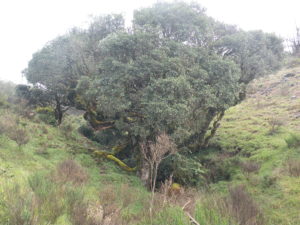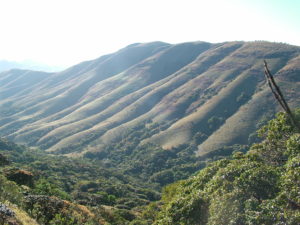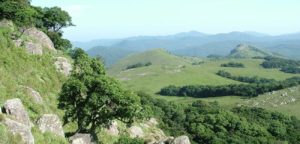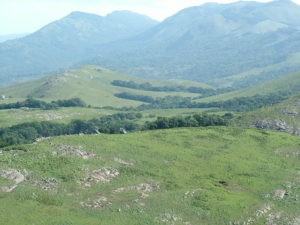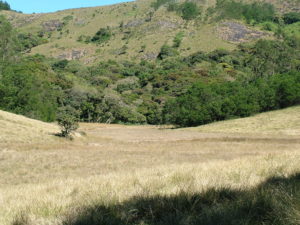Forests
There are numerous kinds of ecosystems in Nilgiri Biosphere Reserve. Forested environments are such a kind of ecosystem, like the Shola Forest found in the Nilgiris district. There are several qualities to a forest, such as but not limited to – supporting and supplying water to a local area (a common feature of the Shola), having available NTFPs (non-timber forest products) to those who rely on the forests for their livelihoods, being a food and shelter source for wildlife, supporting diversity, sustaining oxygen supply, etc. More specifically on the Shola Forests – it is an ecosystem under the category of Tropical Montane Forest (TMF). In other words, it is a type of forested ecosystem that receives an abundant and persistent amount of cloud cover, a unique characteristic of these forests that enables them to soak up moisture from the condensation found on vegetation from condensation of cloud-born moisture. Many rivers in the Western Ghats originate from the Shola- Grassland Mosaic, hence these forests play a critical role in hydrology surrounding environments. In addition, the Shola Forests are habitats for a wide variety of wildlife, both plant and fauna, including species such as the Nilgiri marten and Nilgiri langur that are of conservation conservation. In addition, the Shola is much more nutrient rich than the other landscape counterparts, such as tea or Blue Gum dense forests, and the cycling of nutrients is also much more steady.
In the Nilgiri, forests as well as other wildlife habitats are an ideal source for one of the most evolutionary intricate and intimate partnerships in nature – pollination. With the growing human population in conjunction with the growing demand for food, the natural landscapes are being converted for the purpose of agricultural production, especially for mono crops like tea. By converting these forests into plantations the soil has been eroding more, the diversity as well as abundance of plants species has reduced. Consequentially this has reduced the habitats and resources necessary for many wildlife, such the various honeybee species found in the Nilgiris. Therefore, pollination has also been impacted. As the forests continue to be degraded and fragmented this makes attracting and supporting pollinators, such as honeybee, more and more challenging. This therefore results in a decline in seed and fruit production, and not just for the forest but also for agricultural crops as well. Experiments as well as observations around the world have shown that when natural bee habitats have undergone land use change (otherwise, meaning their forested homes destroyed or reduced) then several crops incur a pollinator deficit.
In other words, lack of native forests is also a serious problem for crops. These very plantations that were cultivated and for which several surrounding forests were felled, also rely heavily upon forests for its natural inhabitant, the honeybee, which pollinates crops and enables growth. Agriculture is necessary for the survival of humans, however it must also be done responsibly with the consideration of wildlife habitats. Both impact one another, as all things are interconnected in this world, and if done well can reap benefits for both the natural and societal aspects of the world. Whether it is habitat support for wildlife (especially those needing to be conserved), enabling the pollination potential both for wild growth and crops, or providing support services and structure for natural systems (i.e. hydrology or biogeochemistry) the Shola Forest is yet another crucial Tropical Montane Forest. Without these distinct forests so many important and natural systems would not be possible. Much more research needs to be done on the specific services these Shola Forests provide, both to other natural environments and wildlife as well as outside communities, but there is no doubt that this ecosystem type is necessary and that it is imperative to sustain them.
Grasslands
Most often in the Nilgiris when there are Shola forests there will also be grasslands (Shola Forest- Grasslands Mosaic), these vast open spaces that are covered in grassy vegetation with a few tree patches dotting the landscape. In general, the Western Ghats are covered with extensive grasslands that can be found adjacent to evergreen forest. It is debatable as to whether the grasslands are a climatic community or are continuously progressing towards the arborescent (tree-like) stage. Nevertheless, grasslands are critical ecosystems that support biodiversity and supply a lot of nutrient resources.
They are referred to by a variety of names, from savannas to prairies, depending on where they are found in the world. Their value ranges from providing cereal grasses (a staple food) for humans, fodder for other species, and even having medicinal plants like lemon grass. In fact, the history of grasslands has been heavily intermixed with that of human civilization, not only as a food source but has also enabled the survival and prosperity of human life. More specifically, cereal cultivation developed alongside the discovery of using fire for cooking as well as domestication of animals. Hence, grasslands contributed to human beings settling down into agricultural communities and thus played a major role in the development of human culture.
It is estimated that prior to human beings creating civilizations, the world’s total land cover was approximately 40% and this has now reduced to about 24%, mostly due to converting grasslands in arable land for crops or range-lands for animal husbandry. In India, it is estimated that there is 13,813 square km of grassy vegetation coverage. There is a move to stop felling forests for the purposes of plantations; however, given the ever-growing demand for food among the human population, land conversion is being done more with natural grasslands.
